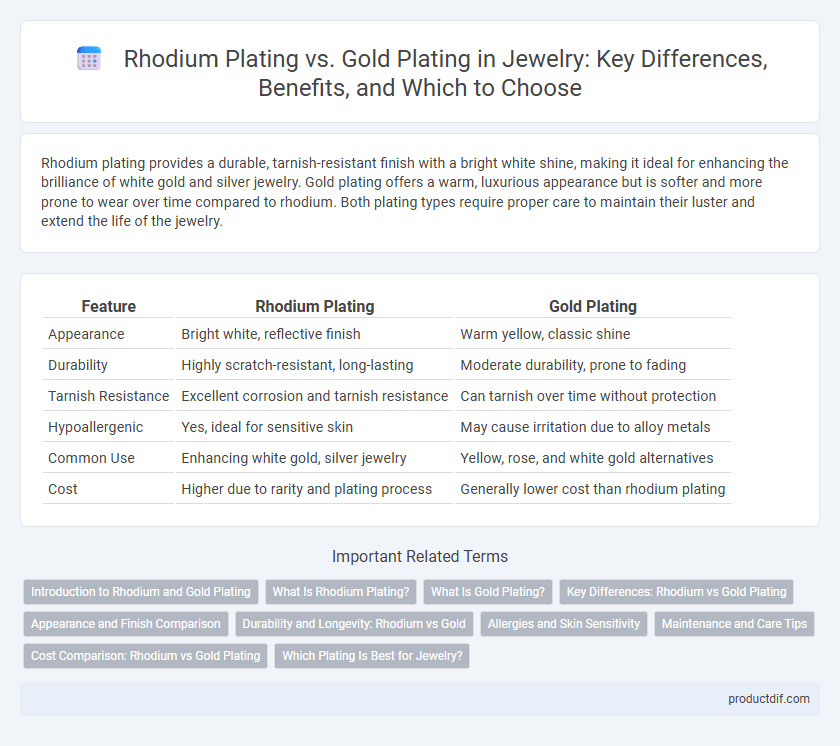Rhodium plating provides a durable, tarnish-resistant finish with a bright white shine, making it ideal for enhancing the brilliance of white gold and silver jewelry. Gold plating offers a warm, luxurious appearance but is softer and more prone to wear over time compared to rhodium. Both plating types require proper care to maintain their luster and extend the life of the jewelry.
Table of Comparison
| Feature | Rhodium Plating | Gold Plating |
|---|---|---|
| Appearance | Bright white, reflective finish | Warm yellow, classic shine |
| Durability | Highly scratch-resistant, long-lasting | Moderate durability, prone to fading |
| Tarnish Resistance | Excellent corrosion and tarnish resistance | Can tarnish over time without protection |
| Hypoallergenic | Yes, ideal for sensitive skin | May cause irritation due to alloy metals |
| Common Use | Enhancing white gold, silver jewelry | Yellow, rose, and white gold alternatives |
| Cost | Higher due to rarity and plating process | Generally lower cost than rhodium plating |
Introduction to Rhodium and Gold Plating
Rhodium plating offers a durable, tarnish-resistant finish that enhances the brilliance and whiteness of white gold and silver jewelry, making it a popular choice for fine jewelry protection. Gold plating involves depositing a thin layer of gold onto a base metal, providing the luxurious appearance of solid gold at a lower cost while varying in thickness and karat quality for durability. Both rhodium and gold plating techniques improve jewelry aesthetics and longevity, with rhodium favored for its hardness and reflective shine, and gold plating prized for its rich, warm color.
What Is Rhodium Plating?
Rhodium plating is a process where a thin layer of rhodium, a rare and durable metal from the platinum family, is electroplated onto jewelry to enhance its shine and prevent tarnishing. This plating is highly valued for its brilliant white finish, superior scratch resistance, and hypoallergenic properties, making it ideal for fine jewelry such as white gold rings and silver pieces. Compared to gold plating, rhodium plating provides greater durability and a reflective, tarnish-resistant surface that maintains jewelry's aesthetic appeal over time.
What Is Gold Plating?
Gold plating is a process where a thin layer of gold is electrochemically bonded to the surface of a base metal, enhancing the jewelry's appearance and resistance to tarnish. This technique provides an affordable way to achieve the luxurious look of solid gold while preserving the durability of the underlying metal, typically brass or silver. The thickness of the gold layer, measured in microns, directly influences the plating's longevity and resistance to wear.
Key Differences: Rhodium vs Gold Plating
Rhodium plating offers a durable, tarnish-resistant finish with a bright white appearance, ideal for enhancing white gold and silver jewelry, while gold plating provides a warm, yellow luster favored for classic gold tones. Rhodium's hardness makes it more scratch-resistant and hypoallergenic compared to gold plating, which may wear off faster and require frequent reapplication. The cost of rhodium plating is generally higher due to rhodium's rarity and durability benefits, whereas gold plating varies based on the karat and thickness applied.
Appearance and Finish Comparison
Rhodium plating delivers a reflective, bright white finish that enhances the brilliance and durability of jewelry, making it highly resistant to tarnish and scratches. Gold plating offers a warm, rich color range from yellow to rose gold but tends to fade over time and requires more frequent reapplication to maintain its shine. The choice between rhodium and gold plating significantly impacts jewelry appearance, with rhodium providing a sleek, modern look and gold plating offering classic, luxurious tones.
Durability and Longevity: Rhodium vs Gold
Rhodium plating offers superior durability and corrosion resistance compared to gold plating, making it ideal for protecting jewelry from tarnish and scratches over time. While gold plating provides a warm, luxurious appearance, its softness results in faster wear and fading, requiring more frequent re-plating. Jewelry coated with rhodium plating maintains its bright, reflective finish longer, especially on white gold and silver pieces, enhancing longevity and preserving value.
Allergies and Skin Sensitivity
Rhodium plating offers a hypoallergenic surface ideal for individuals with sensitive skin or metal allergies, reducing the risk of irritation and allergic reactions commonly associated with base metals. In contrast, gold plating, especially lower karat options, may contain alloys that can trigger skin sensitivity, making it less suitable for allergy-prone wearers. Choosing rhodium plating ensures durability and allergy protection while maintaining a brilliant, tarnish-resistant finish for jewelry.
Maintenance and Care Tips
Rhodium plating requires minimal maintenance due to its high resistance to tarnish and scratches, simply needing occasional gentle cleaning with mild soap and water to preserve its reflective shine. Gold plating, being softer and more prone to wear, demands careful handling and frequent re-plating to maintain its luster, while avoiding exposure to harsh chemicals and abrasive materials. Proper storage in a soft cloth pouch and regular inspections can extend the life of both rhodium and gold plated jewelry, ensuring prolonged brilliance.
Cost Comparison: Rhodium vs Gold Plating
Rhodium plating typically costs more than gold plating due to the rarity and higher market price of rhodium metal, often making rhodium plating a premium choice for jewelry finishing. Gold plating, while less expensive, offers a luxurious appearance with various karat options like 14K and 18K that affect the price. The cost difference also reflects the plating thickness and duration, where rhodium provides a more durable, tarnish-resistant layer but at a higher price point compared to the softer and more oxidizable gold plating.
Which Plating Is Best for Jewelry?
Rhodium plating offers superior durability and tarnish resistance, making it ideal for jewelry that requires long-lasting shine, especially on white gold and silver pieces. Gold plating provides a warm, luxurious appearance but tends to wear off faster, requiring more frequent reapplication to maintain its luster. For everyday jewelry subjected to frequent wear, rhodium plating is generally the best choice due to its hardness and ability to prevent scratching and discoloration.
Rhodium Plating vs Gold Plating Infographic

 productdif.com
productdif.com